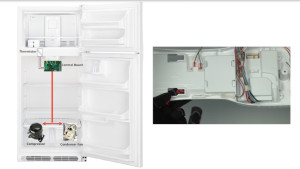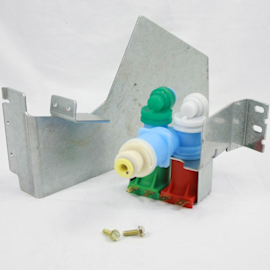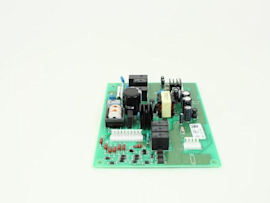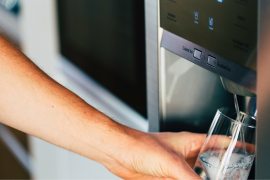Troubleshooting compressor problems in refrigerators video


This video from Sears PartsDirect shows how to troubleshoot problems with your refrigerator’s compressor. The compressor circulates refrigerant throughout the cooling system, so if your refrigerator’s not cooling, the compressor or components that work with the compressor could be to blame.
In this video, learn how to check the start relay, which activates the compressor, the electronic control board, which sends power to the compressor and the wires that connect the two. If one of these components are causing the problem, we’ll show you how to fix them and avoid a potentially costly service call. You also can check out our DIY Refrigerator Repair page for more how-to guides and videos, answers to common questions and error code charts.
Hi, this is Wayne from Sears PartsDirect. Today we’re going to talk about troubleshooting a compressor. If your refrigerator’s not cooling, the compressor could be the problem. For some of these tests, you’ll need a multimeter. If you don’t have one, you can find one here.
Check the start relay
Now, I’m sure you’ve already checked that the refrigerator has power. You may even hear the evaporator fan running. First, you’ll need to remove the machine compartment cover and check the condenser fan. If the condenser fan runs, then your compressor should be getting power because the compressor shares a circuit with the condenser fan motor on most refrigerators.
For safety, unplug the refrigerator. Unhook the retainer clip and pull the PTC start relay out of the refrigerator. Shake the start relay to see if it rattles. If it does, that's a tell-tale sign the relay is fried. Replace the start relay. Here’s a video that will show you how to replace that part.
If the start relay doesn't rattle, you’ll need to check for continuity to confirm that it’s bad. Put the one meter lead into terminal 5 and the other meter lead into terminal 6. If you detect an open circuit between those terminals then the meter will read 1 in the far left digit. You’ll need to replace the PTC relay. If the start relay's okay, then you may have a defective compressor. Unfortunately, you’ll need to get a service technician’s help to replace a compressor, because that repair involves recovering Freon.
Possible thermistor problems
Now, if on the other hand, your condenser fan wasn’t running, then you may have a defective electronic control board or a bad temperature sensor, two problems we can help you diagnose and fix. Many refrigerators, including this Kenmore, have a diagnostic test mode to check refrigerator operations.
To enter the diagnostic test mode on this Kenmore model within 2 seconds press the light switch 3 times, then press and hold it a 4th time until you hear a long beep. You're now in the test mode. If this doesn’t work on your model, check your tech sheet for instructions. You can usually find it located behind the bottom front grill or taped to the back of the refrigerator.
In this test mode, press the door switch twice to start the compressor. The control beeps twice and then you should hear the compressor start. If the compressor runs in the diagnostic test mode, you’ll need to check the thermistor, also known as a temperature sensor. A bad thermistor prevents the compressor from running in normal operating mode. The diagnostic test mode forces the compressor to run whether the thermistor is broken or not. This video will show you how to further diagnose a broken thermistor.
Electronic control board gone bad
If the compressor doesn't start in the diagnostic test mode, you’ll need to check continuity from the electronic control board through the compressor circuit. With the refrigerator unplugged, remove the screw that holds the control box. Pull the control box down and remove the electronic control board. Unplug the connector from the compressor circuit. Put one meter lead on the red wire and the other meter lead on the blue wire.
If you see around 5 ohms on the meter, it means you have continuity. If the compressor circuit shows continuity, you'll probably need to replace the electronic control board because the board is not sending voltage through the circuit to the compressor. Check out this video to learn how.
Possible broken wires
If the compressor circuit is open, you’ll see a 1 in the far left digit on the meter. Look for pinched or broken wires in the control board harness and on the wires leading up to the compressor. Repair or replace any broken wires that you find. Even if the wires look okay, you should still check continuity to see if there’s a problem with the control board harness.
Unplug the wire harness from the ceiling, and check continuity between the ceiling plug and the control board plug on the blue wire and the red wire. If the control board harness is okay, then plug it back in and check continuity between the red wire at the control board plug and the red wire on the compressor plug. If the red wire is good, check the blue wire next. If both wires have continuity, and the start relay wasn't the problem, you’ll need to have the compressor replaced.
Well, I hope this video helped you out today. Be sure to check out our other videos here on the YouTube channel and don’t forget to subscribe.
Most common symptoms to help you fix your refrigerators
Choose a symptom to see related refrigerator repairs.
Main causes: control board or cold control failure, broken compressor start relay, compressor motor failure, defrost tim…
Main causes: jammed ice cubes, broken ice maker assembly, dirty water filter, kinked water line, bad water valve, freeze…
Main causes: water valve leaking, frozen or broken defrost drain tube, overflowing drain pan, cracked water system tubin…
Main causes: damaged door seal, faulty defrost sensor or bi-metal thermostat, broken defrost heater, bad defrost timer o…
Main causes: blocked vents, defrost system problems, evaporator fan failure, dirty condenser coils, bad sensors, condens…
Main causes: blocked air vents, compressor problems, condenser or evaporator fan not working, control system failure, se…
Main causes: leaky door gasket, defrost system failure, evaporator fan not running, dirty condenser coils, condenser fan…
Things to do: clean condenser coils, replace the water filter, clean the interior, adjust doors to prevent air leaks, cl…
Most common repair guides to help fix your refrigerators
These step-by-step repair guides will help you safely fix what’s broken on your refrigerator.

How to replace a refrigerator water valve
Replace the water valve that feeds water to the ice maker and water dispenser if it no longer controls the flow of water…

How to clean refrigerator condenser coils
Help your refrigerator run more efficiently by cleaning the condenser coils. It's easy and takes just a few minutes.…

How to replace a refrigerator temperature control board
If the temperature in your refrigerator doesn't match the temperature you set, the problem could be the temperature cont…
Effective articles & videos to help repair your refrigerators
Use the advice and tips in these articles and videos to get the most out of your refrigerator.

No matter what style Maytag refrigerator you have, we can walk you through replacing the water filter.…

Learn about all the convenient features on our Sears PartsDirect website that make your parts purchases easier.…

Get tips and advice on replacing the water filter in your LG refrigerator.…
